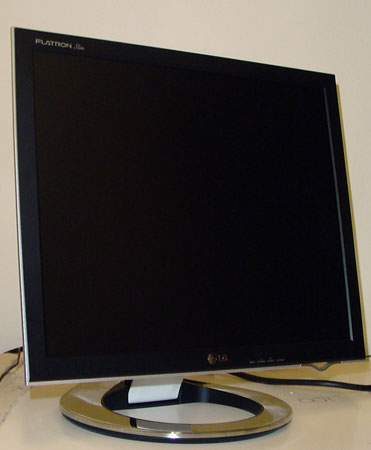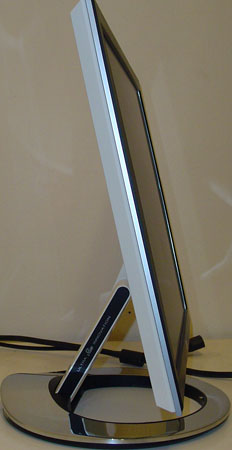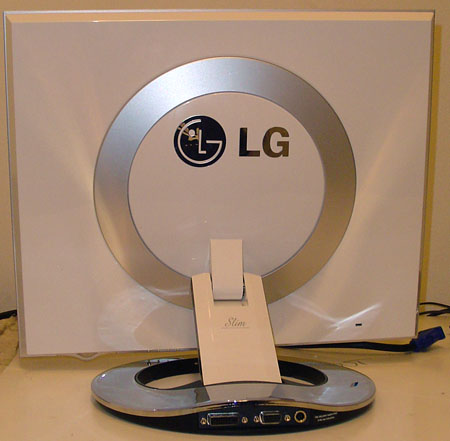LG L1980U LCD: The New 19" Panel on the Block
by Kristopher Kubicki on May 13, 2005 4:00 PM EST- Posted in
- Displays
Construction
Our Flatron L1980U bears a striking resemblance to the Samsung 193P display that we reviewed over a year ago. Both displays use internally housed cable management that run down the rear of the unit, external power supplies and nice, round curving bezels behind the monitor. The LG unit is actually slightly thinner than the SyncMaster 193P, but does not have a universal joint attached to the base. Hence, this display only tilts along the X axis and pivots along the Y axis. The L1980U boasts the specifications listed below:| LG Flatron L1980U | |
| Advertised LCD | 19" SXGA LCD (Active Matrix) pixel pitch: 0.294mm Anti-glare coating TN 6-bit LCD Panel |
| Advertised Scanning Frequency | Horizontal: 30-83kHz Vertical: 56-75Hz |
| Advertised Response Time | 12ms (Typical Gray to Gray) |
| Advertised Viewing Angle | 160 / 160 (Horizontal / Vertical) |
| Advertised Contrast Ratio | 500:1 (Typical) |
| Advertised Compatibility | 1280 x 1024 (Native) |
| Advertised Brightness | 250 cd/m2 |
| Advertised Warranty | 3 years parts and labor |
The first thing that you may notice is the 12ms advertised response time. Unfortunately, there is a growing trend with display manufacturers to not mention whether or not the response time is gray-to-gray (GTG) or average (TrTf) response time. LG.Philips LCD also lists this panel as a 12ms response time unit, but then again, they also list the previous generation panels as 12ms too (the same panel used in our 16ms Sharp LL-191A-B). After much investigation, we determined that the response time was actually 12ms average (TrTf - Time rising, Time falling) response time, but LGE typically advertises the display as an 8ms unit. This is still technically correct, since the display does in fact take 8ms for the Tr (Time rising) – although this does not seem to be explicitly mentioned anywhere convenient. Just keep in mind that this is a low response time LCD, but not lower than other displays that we’ve seen in the past.
Clever marketing aside, there are some other interesting aspects of this display. This is one of the slimmest displays that we have seen to date, and when folded into the monitor, it is only four inches high. The monitor comes with an extra VESA compatible mount plate that can be attached to the base of the unit if you plan on attaching the L1980U to the wall or a VESA arm. Below, you can see another shot of the awesome cable management running down the rear of the display.
Like most LCDs that use intelligent cable management, the LGE L1980U requires an external inverter brick. Using a Kill-A-Watt device to measure power consumption, we found that the display uses 43W when on and just under 2W when on standby (just as the LGE website states). Like the Samsung 193P, there are no exhaust portals on the monitor either. The majority of heat generated in an LCD comes from the AC inverter, so we were not surprised that LG was able to pull this off.













21 Comments
View All Comments
nthexwn - Sunday, May 15, 2005 - link
I still like my Samsung 710T for gaming ;) Any word on 8ms displays?phaxmohdem - Sunday, May 15, 2005 - link
LOL Wish this article was published a day sooner. Not even 24 hours before this story went online, I walked out of my local Sams Club store toting two brand new Samsung 913V 19" LCD monitors. I paid around $350 ea for them.It was worth it though, these suckers have an 800:1 contrast ratio and are the durn purdiest monitors I have ever pwn3d. There is not much info online about this particular model, but I would recommend them to anyone in the 19" market. only down sides so far, is no DVI input and teh bases are not adjustable, just a tilt option. (and some ghosting on games which is to be expected from a 25ms monitor.)
BUBKA - Saturday, May 14, 2005 - link
wouldn't it be nice if somebody did a monitor review without a Matrix text complete with screenshot...g33k - Friday, May 13, 2005 - link
Thanks for the review. I enjoyed the read and as I am in the market for a new monitor, this will definitly help in my buying descisions.Spacecomber - Friday, May 13, 2005 - link
Sorry, one more comment. I believe the LG1930B uses a LG Philis S-IPS panel, though it is rated as only a 25ms panel. Still, this monitor might compare well against the Dell 1905FP, and NewEgg currently is selling it for $288 after a mail-in rebate. This might be another interesting 19" LCD monitor to take a look at.Ok, I think I'm done now.
Space
Spacecomber - Friday, May 13, 2005 - link
Thanks for this review. Trying to keep up with how these 19" monitors stack up against each other is important to me, since they do seem to be the sweet spot for recommending a LCD to someone these days (as you noted).I think some of these have been mentioned before, but an interesting comparison would be this monitor to the Hyundi L90D+, which uses a Samsung TN panel, and the Viewsonic VP912B, which I think uses the AUO panel. At the moment, I would think that the Hyundi L90D+ gets the nod for a fast gaming monitor, because of its cost, about $350.
I know you guys really like the Dell 1905FP, but its PVA panel is really too slow for games. In fact, I would like to see the 1905FP compared against the Samsung 910T. Although the 910T is rated as a 25ms panel and the Dell a 20ms panel, I didn't think there was much difference between them when it comes to games. The 5ms reported difference in response times is for black to white transitions, and this doesn't really reflect how the PVA monitor has so much trouble with black to grey transitions. The small 5 ms difference gets washed away by the high response times in these situations.
And, I personally liked the much more extensive control features available on the 910T, compared to the Dell. Currently the 910T is available for $349 at NewEgg after a $50 mail in rebate, and they even have the 193P for $392, after a $200 rebate. So, the market for LCDs using Samsung's PVA panels is actually fairly tight.
A couple of other monitors that I'd like to ask you to keep an eye out for, as they sound quite interesting, are the Samsung 193P plus and the Eizo L778. The 193P+ is suppose to be a 8ms PVA panel. I'm still skeptical if this will really make any difference in games, but inquiring minds want to know. The L778 is also a PVA panel, but Eizo claims that their "overdrive circuit" keeps the response times at a low level across the spectrum of black to grey transitions. If this is true, then this PVA panel might rival the S-IPS panels as coming close to being a good all-around LCD monitor.
Some links:
http://www.eizo.com/products/lcd/l778/index.asp
http://product.samsung.com/cgi-bin/nabc/product/b2...
Thanks again,
Space
ocyl - Friday, May 13, 2005 - link
Good poundings on the 6-bit panels, Kristopher! Keep them going :D !!!Samadhi - Friday, May 13, 2005 - link
1280x1024, it's about time someone produced a higher resolution 19" display.rqle - Friday, May 13, 2005 - link
I like these flatron monitor, burrow friend LCD to carry around. I would only pay 15% more then a dell though, so price is a bit high for me.xpose - Friday, May 13, 2005 - link
Nice review. I am glad my Dell is still the champ. hehee. Plus I paid 297.00 +tax shipping for the UltraSharp 1905FP just last week. With a price like that, this monitor doesnt stand a chance.